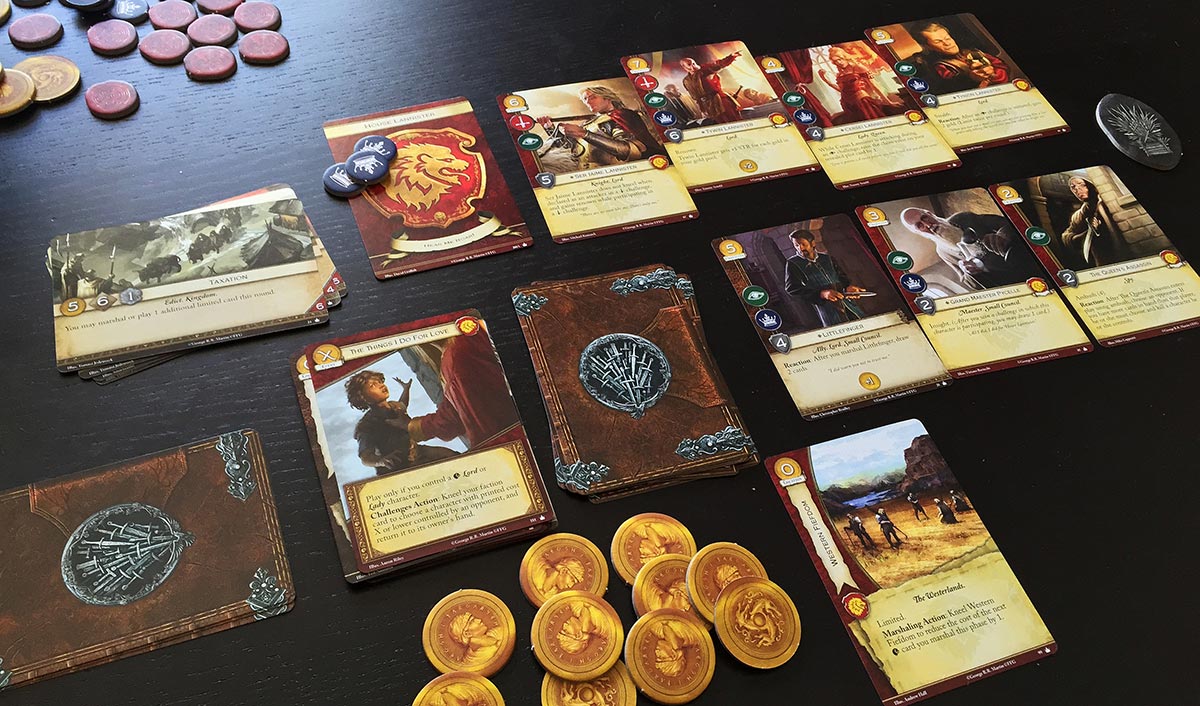Building Your Deck – Part 1
In my opinion the best part of playing LCGs is the deck building. I may not be good at it for some games but I have been known to put together some mean combos in other games. The awesome part of all LCGs is how deck building works. So today I would like to take some time to talk about the rules and mechanics for some of the systems I like best!
Star Wars: The Card Game

Objectives are on the left side of each players board, while units and enhancements are in the middle. Source
This is currently one of my favorite deck building systems. In this game each player brings two decks, a Light side deck and a Dark side deck. Both decks contain two sub -decks: an objective deck and a draw deck. I know what you are thinking, “TOO MANY DECKS TO BUILD, WTF KYLE” but in reality you only really need to build one. To start there are three sub-factions per side. Dark side has Scum and Villainy, Sith, and Imperial Navy. Light side has Smugglers and Spies, Jedi, and Rebels. Each objective deck will determine which resources can be generated for each faction. In order to play a card, at least one of the resources spent must be of that card’s faction. This is the key.
For example, If I wanted to build a Dark side deck, I pick an affiliation card (Sith, Scum and Villainy, or Imperial Navy) which generates one resource for that faction. Then I choose 10 Dark side objectives I want to make up my objective deck. These will generate the rest of the resources for me to play my cards. Which cards you ask? Well each objective comes with a set of 5 cards. These 5 cards from all 10 objectives make up your 50 card draw deck! BOOM. It is a really awesome system. Choose your ten objectives and build both decks at the same time! I think superficially the system seems like you lose a lot of finesse when deck building, but in reality the system allows for the inclusion of anything from the same faction you are building. So the combinations of objectives and their “pod”, as it is referred to in the meta, really matters. Maybe you want a pod only for one card in it or maybe you only want a pod for its objective? Who knows but it facilitates a really awesome way of thinking about building a deck.
A Game of Thrones: The Card Game

We see the plot deck on the top left while the character cards and locations are on the right hand side of the draw deck. Source
This system is also very unique. The game revolves around the GoT Houses. In the most basic deck you choose a House that represents the deck you are playing. This allows you access to that House’s cards and any neutral cards. This game also has a secondary deck but each player only has one deck they bring to tournament play. The other deck is called the plot deck. Same as with the main (draw) deck, the House card allows for you to include any plot cards for that House and any neutral plot cards. So you have to build one deck of 60 cards (your draw deck) and one deck of 7 cards (your plot deck). Sounds kind of boring at first right? However there is one more thing, Agenda Cards.
Agenda Cards manipulate the rules for including cards in your deck. Some agenda cards are simply Banners from other houses that let you play non-loyal cards from a different faction, but force you to include at least 12 of that faction’s cards in your draw deck. Other agendas manipulate other rules in the game. Lords of the Crossing allows you to play a more rush style deck as long as you can initiate all three challenges a turn. The Rains of Castamere allows you to play extra plot cards in your plot deck and use them mid-turn if you win certain challenges. Fealty allows you to play your loyal cards for cheaper, but doesn’t let you include any other faction. There are so many agenda cards that have the potential to be released. In fact one of the newly spoiled ones allows you to play with two Banner cards but you have to have a 70 card deck. To me this is an awesome aspect of deck building that allows one to play different types of games with their opponent. Change the rules and win your way!
That is all for today! Next time I will cover Android: Netrunner and Warhammer 40,000 Conquest. If you have any comments or question put them in the comments. Living Card guy out!
-Kyle
